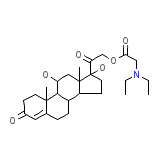Ulcort




Ulcort Brand names, Ulcort Analogs
Ulcort Brand Names Mixture
- Bot-Plus Syringe Formula Equine Wormer (Mebendazole + Trichlorfon)
- Equiverm B Pst (Mebendazole + Trichlorfon)
- Telmin B Syringe Formula (Mebendazole + Trichlorfon)
Ulcort Chemical_Formula
C27H41NO6
Ulcort RX_link
No information avaliable
Ulcort fda sheet
Ulcort msds (material safety sheet)
Ulcort Synthesis Reference
No information avaliable
Ulcort Molecular Weight
475.618 g/mol
Ulcort Melting Point
No information avaliable
Ulcort H2O Solubility
No information avaliable
Ulcort State
Solid
Ulcort LogP
2.953
Ulcort Dosage Forms
Ointment; Cream
Ulcort Indication
Used topically as an antiinflammatory in the treatment of steroid-responsive dermatoses
Ulcort Pharmacology
Hydrocortamate is a synthetic glucocorticoid used for its anti-inflammatory or immunosuppressive properties to treat inflammation due to corticosteroid-responsive dermatoses. Glucocorticoids are a class of steroid hormones characterised by an ability to bind with the cortisol receptor and trigger a variety of important cardiovascular, metabolic, immunologic and homeostatic effects. Glucocorticoids are distinguished from mineralocorticoids and sex steroids by having different receptors, target cells, and effects. Technically, the term corticosteroid refers to both glucocorticoids and mineralocorticoids, but is often used as a synonym for glucocorticoid. Glucocorticoids suppress cell-mediated immunity. They act by inhibiting genes that code for the cytokines IL-1, IL-2, IL-3, IL-4, IL-5, IL-6, IL-8 and TNF-alpha, the most important of which is the IL-2. Reduced cytokine production limits T cell proliferation. Glucocorticoids also suppress humoral immunity, causing B cells to express lower amounts of IL-2 and IL-2 receptors. This diminishes both B cell clonal expansion and antibody synthesis. The diminished amounts of IL-2 also leads to fewer T lymphocyte cells being activated.
Ulcort Absorption
No information avaliable
Ulcort side effects and Toxicity
Side effects include burning, itching, irritation, dryness, folliculitis, hypertrichosis, acneiform eruptions, hypopigmentation, perioral dermatitis, allergic contact dermatitis, maceration of the skin, secondary infection, skin atrophy, striae, miliaria.
Ulcort Patient Information
http://www.drugs.com/MMX/Homatropine_Methylbromide.html
Ulcort Organisms Affected
Humans and other mammals














